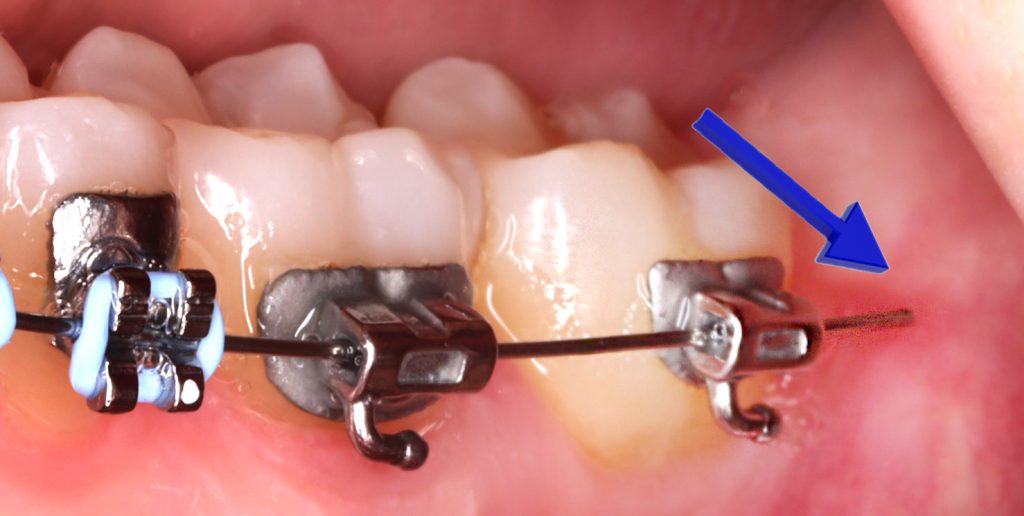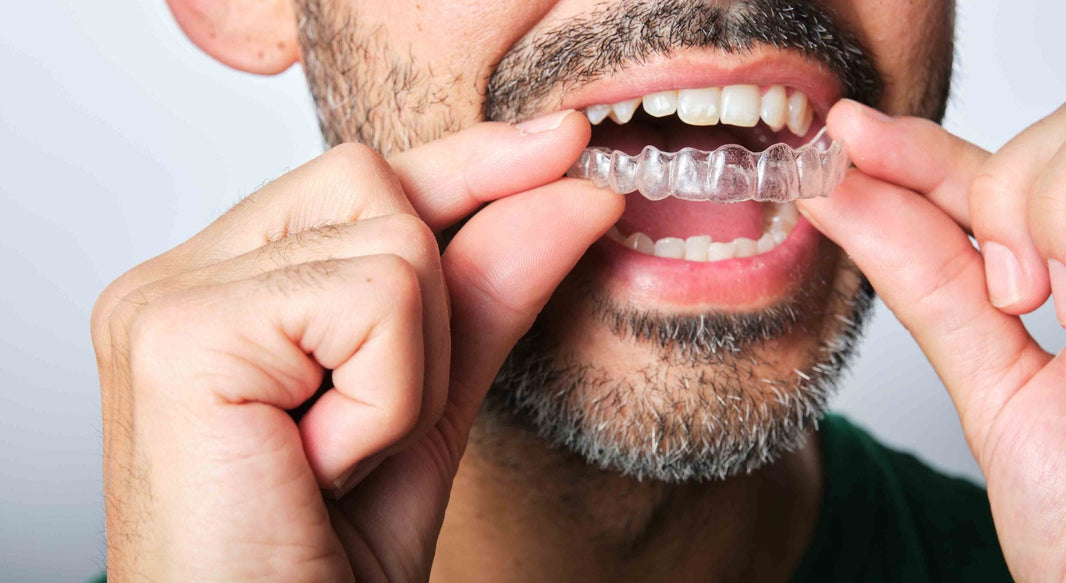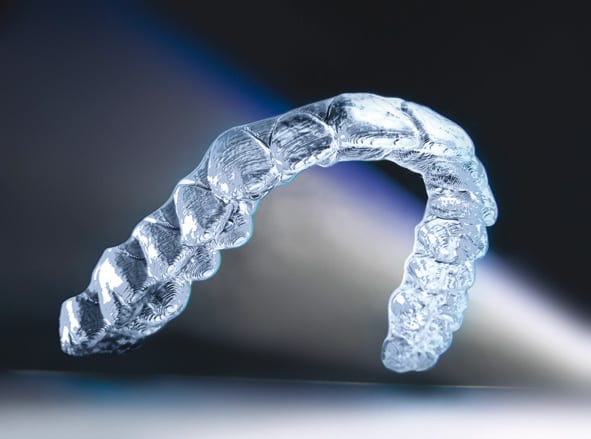Braces are designed to gradually align your teeth—but sometimes the hardware needs a little adjusting of its own. A common issue during treatment is a wire that begins to poke the inside of your cheek or gums, often caused by shifting teeth or accidental pressure from food or brushing.
While a pokey wire may not require emergency dental care, it can quickly become irritating and even painful if not handled properly. Fortunately, there are safe, effective at-home strategies that can keep you comfortable until you’re able to see your orthodontist.
Table of contents
Poking Wire from Braces
Why Braces Wires Poke
The archwire is the thin, flexible metal that runs across your braces, applying tension to move your teeth into alignment. Over time, as your teeth shift into place, the archwire may begin to extend past the last bracket—especially on the back molars.
In other cases, the wire can move or become dislodged due to chewing, brushing, or sudden pressure. These issues are not uncommon and tend to arise during active phases of tooth movement.
When a wire becomes exposed or dislodged, it can irritate or cut into your cheeks, lips, or tongue. This often starts as mild discomfort but can quickly escalate into a sore or lesion if left unaddressed. Recognizing the signs early and taking proactive steps can help prevent small problems from becoming painful ones.
Wire extends beyond the back bracket as teeth move
Archwire becomes displaced from a bracket
Wire bends due to chewing or trauma
Thin ligature wires shift or loosen
When to Seek Orthodontic Attention
A pokey wire usually doesn’t qualify as a dental emergency, but that doesn’t mean it should be ignored. Certain symptoms indicate it’s time to schedule an appointment with your orthodontist, especially if your comfort or treatment progress is being affected. Knowing the difference between minor irritation and a more serious issue can help you respond appropriately.
If a wire is causing visible injury or pain that prevents you from eating, sleeping, or speaking normally, it’s best to seek care promptly. Even small misalignments in your brace's hardware can affect treatment if not corrected in a timely manner. And if you're at-home fix doesn’t hold or the issue recurs quickly, a professional adjustment may be required.
Wire is causing bleeding or persistent pain
A bracket is loose or completely detached
You are unable to eat, speak, or sleep due to discomfort
You’ve attempted a fix but the wire remains exposed

How to Fix a Poking Wire from Braces at Home
Sometimes your orthodontist isn’t immediately available—on weekends, during holidays, or after hours. In those cases, there are safe and simple ways to manage a poking wire at home using tools you likely already have. These temporary fixes can minimize irritation and help you stay comfortable until your next dentist appointment.
Always start by washing your hands and sterilizing any tools. Use a well-lit mirror and take your time. If you’re unsure about what to do—or if anything feels painful or risky—don’t force it. These tips are meant to reduce discomfort, not replace professional care.
Orthodontic Wax
Dental Wax is your first line of defense against poking wires. It provides a soft barrier between the wire and your mouth, preventing cuts and irritation. This is the safest and most effective method for protecting your cheeks and gums, especially if you’ve just started treatment or are dealing with shifting wires.
What to do:
Brush your teeth and dry the area with gauze or a cotton swab
Wash your hands thoroughly
Roll a small piece of unused wax into a pea-sized ball
Press it firmly over the pokey wire until it stays in place
Remove the wax when eating or brushing, and reapply with clean wax
Pencil Eraser
If wax for braces doesn’t help or isn’t available, a clean pencil eraser can be used to reposition the wire. This method is especially useful for thinner wires that are causing irritation but haven’t completely dislodged. While this won’t fix the problem long-term, it can provide relief when you're in a bind.
What to do:
Use a pencil with a clean, unused eraser
Pull your cheek away from the wire
Carefully push the wire closer to the tooth or under the bracket
Avoid forcing the wire or applying too much pressure
Remove the wax when eating or brushing, and reapply with clean wax
Tweezers
Tweezers can help reposition an archwire that has slipped out of the last bracket. This often happens during active tooth movement, and it can be addressed safely if done gently and with clean tools. You may also use tweezers to adjust smaller ligature wires that are poking outward.
What to do:
Clean the tweezers with rubbing alcohol or soap and hot water
Use a mirror and bright lighting to locate the wire
Grasp the wire with tweezers and slide it back into the bracket slot
Apply wax afterward if the area still feels sharp
Nail Clippers or Wire Cutters (Last Resort)
Cutting a wire should only be done if no other solution works and the discomfort is severe. This method can bring immediate relief but should be approached with caution. Make sure an adult assists you, and be careful not to clip any part of the bracket or surrounding hardware.
What to do:
Have an adult assist you
Wash and dry the area before beginning
Use sterilized nail clippers or wire cutters to carefully snip the exposed end
Catch the clipped piece with tissue to avoid swallowing
Apply wax to the clipped end and call your orthodontist for follow-up care
Preventing Future Wire Problems
Good habits go a long way when it comes to keeping your braces trouble-free. While some pokey wires are inevitable as teeth move, many instances can be avoided with smart precautions.
Being mindful of what you eat and how you care for your braces can help you prevent discomfort and treatment delays. Prevention also means protecting your mouth from injury. If you play sports or grind your teeth at night, be sure to use a mouthguard.
And always alert your orthodontist at regular checkups if something feels off with your braces—fixing a small issue early is better than dealing with a painful one later.

Avoid hard, crunchy, or sticky foods like popcorn and nuts
Cut food into smaller pieces to reduce bite pressure
Wear a mouthguard when playing sports
Attend all orthodontic checkups for adjustments and wire trims
Final Note: Oral Hygiene Is Critical
Maintaining excellent hygiene is especially important when dealing with a pokey wire. Food and bacteria can collect around the exposed area, increasing the risk of sores or infection. Keeping your teeth and gums clean will not only help wounds heal faster—it also ensures your braces continue working properly.
It’s important to brush and floss carefully, especially around any area affected by the wire. Use a soft-bristled toothbrush and rinse often to keep the mouth clean. Wax should be removed and reapplied regularly, especially after meals or brushing.
Rinse and brush after meals
Keep brackets and wires clean
Attend all scheduled appointments
Is a broken bracket an emergency?
Not typically, but it does require timely attention. A broken bracket isn’t a dental emergency unless it’s causing pain, bleeding, or interfering with your bite. However, leaving it untreated can slow your treatment progress or lead to wire displacement, so it’s important to contact your orthodontist for an emergency repair appointment.
Are ceramic brackets more likely to break than metal ones?
Ceramic brackets are strong, but slightly more brittle than traditional metal brackets. They can be more prone to chipping or detaching when exposed to sudden impact or stress from hard foods. If aesthetics are important but you're concerned about durability, your orthodontist may recommend hybrid systems that combine ceramic fronts with metal brackets in the back.
What should I do if my child breaks a bracket at school?
If your child reports a broken bracket while at school, encourage them not to touch or wiggle it. If discomfort is present, they can apply orthodontic wax (if available) or notify the school nurse for help until you can assess the issue. Contact your orthodontist after school hours to schedule a repair and determine if an emergency visit is necessary.
What happens if I don’t repair a broken bracket?
Delaying a repair can disrupt the way force is applied to your teeth, potentially slowing progress or causing unwanted tooth movement. In some cases, it may even extend your overall treatment time. It’s best to schedule an emergency appointment as soon as you notice the break so your orthodontist can make the necessary adjustments.
Time to Book?
A pokey wire doesn’t require panic—but it does require action. If you’re experiencing ongoing discomfort or can’t resolve the issue at home, you’ll likely need to schedule an emergency orthodontic visit. This type of appointment is separate from your regular adjustment and is meant to address urgent concerns like exposed wires, loose brackets, or hardware that’s causing pain or interfering with your daily activities.
Waiting until your next scheduled visit may prolong discomfort or lead to complications in your treatment progress. Your orthodontist can quickly assess the situation, trim or reposition the wire, and get you back on track with minimal disruption.






